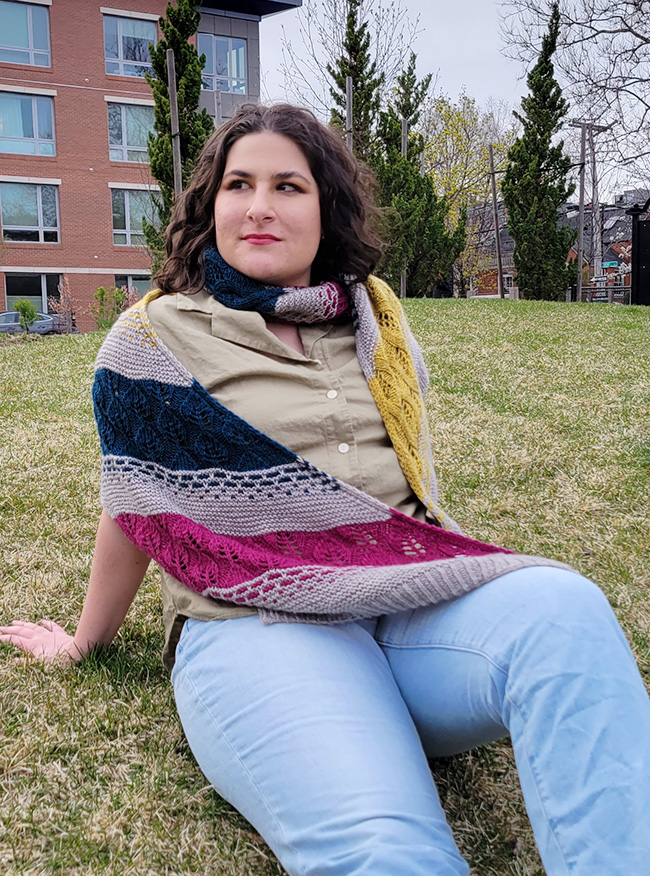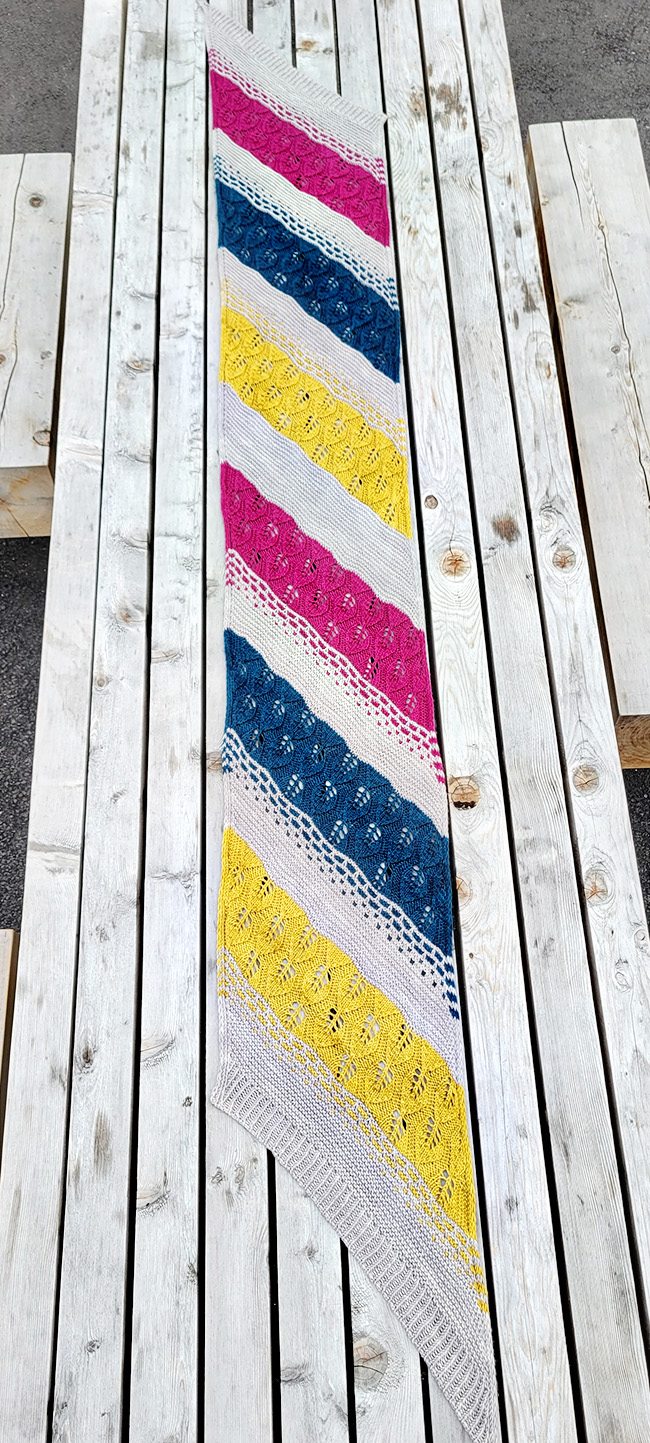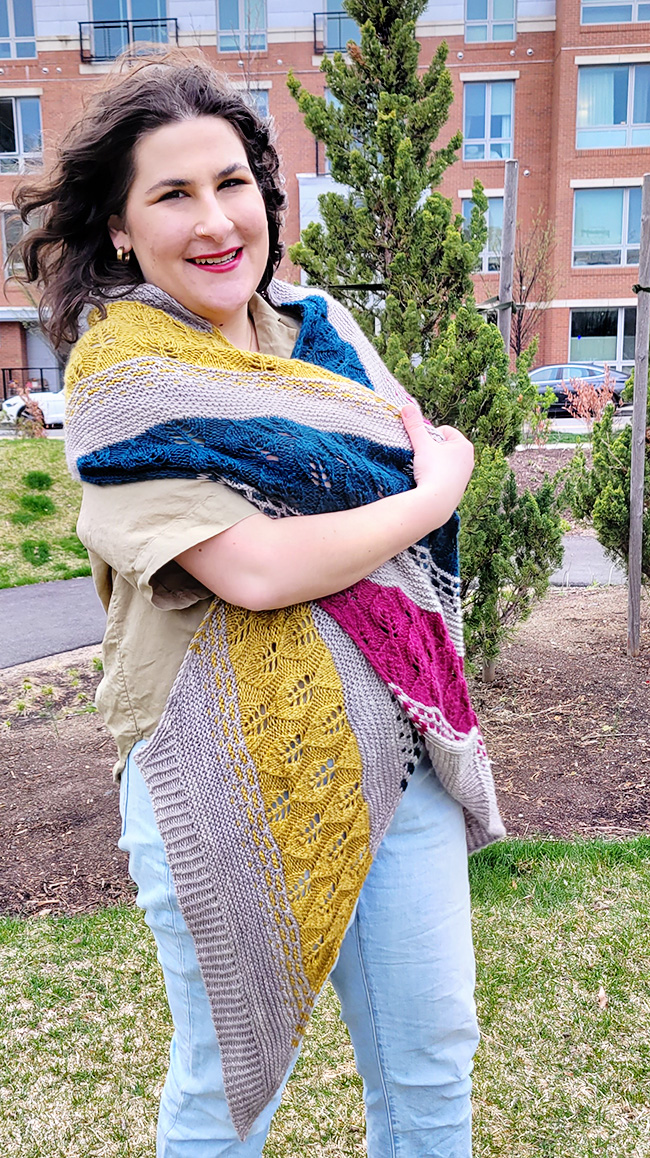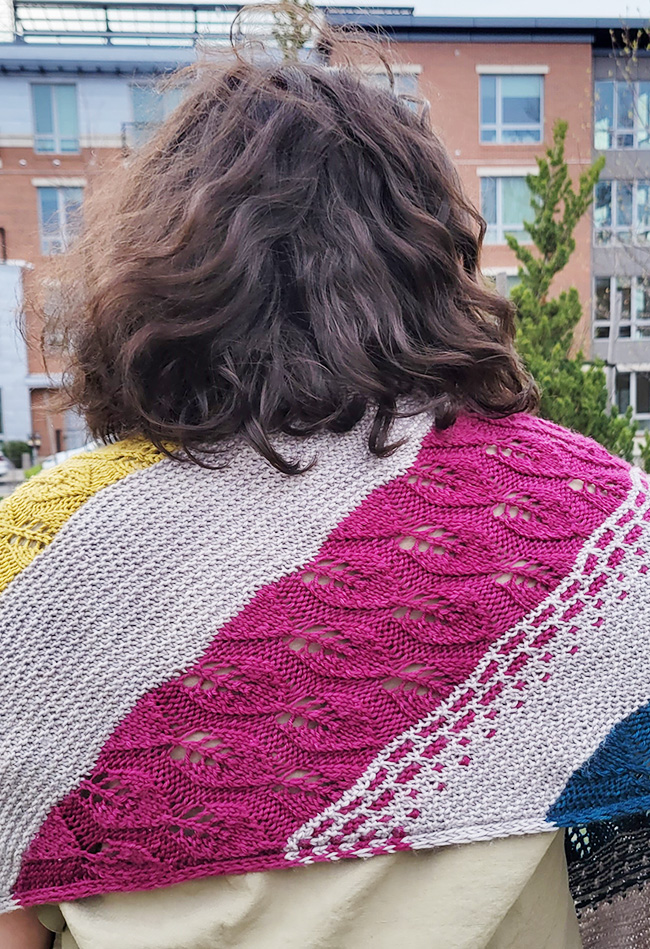Valerian, a free knitting pattern from Knitty.com.
INTRODUCTION
Valerian
 by Caroline Pasyanos
by Caroline Pasyanos
![]()
I created this design after finishing all of my holiday knitting for the year. After everything I'm making for gifts is off the needles, blocked, and ends woven in, I like to sit back and relax with a purely self-indulgent project. I pulled out some yarn that I was saving for a special project – a skein of Miss Babs Yowza and a trio of minis for contrast – and started brainstorming. After flipping through some stitch dictionaries for inspiration, I decided to mix a textural lace stitch with panels of garter stitch and mosaic colorwork. Finally, I decided to work it on the bias just to keep things interesting, and this design was born.
I named the wrap after the herb valerian root as a callback to the plant motif in the lace, but also because the root Latin word valere means to be worthy, healthy, and to prevail. I hope that these words apply to anyone who wears it.
Valerian is a very versatile garment. It can be worn draped around the shoulders as an elegant wrap, or as a cozy scarf around the neck when the temperature drops. Because it is worked in DK weight and the lace sections are broken up by simple garter stitch, it practically flies off the needles.
I chose to work mine up in a neutral main color and beautiful jewel tones that remind me of fall, but the possibilities are endless! I would love to see this with a dark main color and lighter contrasts, or even a bright main color and more neutral contrasts.
 model: Caroline Pasyanos
model: Caroline Pasyanos
 photos: Kyle Talbot, Caroline Pasyanos
photos: Kyle Talbot, Caroline Pasyanos
SIZE
One
FINISHED MEASUREMENTS
Width: 19.5 inches/49.5 cm
Length: 87 inches/221 cm
MATERIALS
Yarn
Miss Babs Yowza [100% Superwash Merino; 560yd/512m per 225g skein];
![]() [MC] Oyster; 1 skein
[MC] Oyster; 1 skein
Miss Babs Yowza Mini [100% Superwash Merino; 200yd/182m per 80g skein];
![]() [CC1] Aubergine; 1 skein
[CC1] Aubergine; 1 skein
![]() [CC2] Franklin; 1 skein
[CC2] Franklin; 1 skein
![]() [CC3] Cumin; 1 skein
[CC3] Cumin; 1 skein
Yarn Characteristics
![]() The sample uses approximately 450 yds/410m of MC and 165 yds/150m of each CC. For a project using 6 different CCs, you would need approx. 85 yards/80 m per color. When choosing colors, make sure that the MC has enough contrast with each CC so that the mosaic pattern shows up. Variegated or speckled colorways would work for the MC (and the garter sections will show off the yarn beautifully) as long as there is enough contrast with CCs. The CCs should all be solid or semi-solid colorways, because the lace will not show up as well with a variegated colorway, and they should not be too dark or the lace pattern will get lost.
The sample uses approximately 450 yds/410m of MC and 165 yds/150m of each CC. For a project using 6 different CCs, you would need approx. 85 yards/80 m per color. When choosing colors, make sure that the MC has enough contrast with each CC so that the mosaic pattern shows up. Variegated or speckled colorways would work for the MC (and the garter sections will show off the yarn beautifully) as long as there is enough contrast with CCs. The CCs should all be solid or semi-solid colorways, because the lace will not show up as well with a variegated colorway, and they should not be too dark or the lace pattern will get lost.
Recommended needle size
[always use a needle size that gives you the gauge listed below - every knitter's gauge is unique]
![]() 1 set US #4/3.5mm needles for working flat
1 set US #4/3.5mm needles for working flat
Notions
![]() stitch markers
stitch markers
![]() tapestry needle for weaving in ends
tapestry needle for weaving in ends
![]() blocking mat
blocking mat
![]() blocking wires or pins
blocking wires or pins

GAUGE
19 sts/30 rows = 4 inches/10cm in st stitch
19 sts/32 rows = 4 inches/10 cm in garter stitch, after a stretch blocking
16 sts / 34 rows in Cable/Lace pattern repeat measures 3.25 inches / 8.25 cm wide and 4.5 inches / 11.5 cm long
PATTERN NOTES
[Knitty's list of standard abbreviations and techniques can be found here.]
The long-tail tubular cast on and sewn tubular bind off work best for this project as they mimic the look and stretch of 1x1 ribbing.
Note: for the cast on,
the slip knot counts as your first knit stitch, so you will end the CO with a knit stitch.
Alternatively, you could CO using the Knitted-on method:
If you are using a cast-on method other than the long-tail tubular cast on, omit the first two rows of setup and begin working from Row 3.
Sewn Tubular Bind off.
Bias Twisted Rib
Row 1 [RS]: Sl1 wyib, p1, k1tbl, p1, ssk, (k1tbl, p1) to last 5 sts, k1tbl, m1L, p1, k1tbl, p1, k1.
Row 2 [WS]: Sl1 wyif, (k1, p1tbl) twice, (p1tbl, k1) to last 6 sts, p2tbl, k1, p1tbl, k1, p1.
Row 3: Sl1 wyib, p1, k1tbl, p1, ssk, (p1, k1tbl) to last 5 sts, m1Lp, (k1tbl, p1) twice, k1.
Row 4: Sl1 wyif, (k1, p1tb) to last 2 sts, k1, p1.
Bias Garter
Row 1 [RS]: Sl1 wyib, p1, k1tbl, p1, ssk, k to last 4 sts, m1L, p1, k1tbl, p1, k1.
Row 2 [WS]: Sl1 wyif, k1, p1tbl, k to last 3 sts, p1tbl, k1, p1.
Bias Mosaic
Row 1 [Color A - RS]: Sl1 wyib, p1, k1tbl, p1, ssk, sl2 wyib, [k1, sl3 wyib] to last 7 sts, k1, sl2 wyib, m1L, p1, k1tbl, p1, k1.
Row 2 [WS]: Sl1 wyif, k1, p1tbl, k2, sl2 wyif, (k1, sl3 wyif) to last 8 sts, k1, sl2 wyif, k2, p1tbl, k1, p1.
Row 3 [Color B]: Sl1 wyib, p1, k1tbl, p1, ssk, k to last 4 sts, m1L, p1, k1tbl, p1, k1.
Row 4: Sl1 wyif, k1, p1tbl, k to last 3 sts, p1tbl, k1, p1.
Rows 5-6 [Color A]: Repeat Rows 1-2.
Rows 7-8 [Color B]: Repeat Rows 3-4.
Row 9 [Color A]: Sl1 wyib, p1, k1tbl, p1, ssk, (sl1 wyib, k3) to last 5 sts, sl1 wyib, m1L, p1, k1tbl, p1, k1.
Row 10: Sl1 wyif, k1, p1tbl, k2, (sl1 wyif, k3) to last 6 sts, sl1 wyif, k2, p1tbl, k1, p1.
Rows 11-12 [Color B]: Repeat Rows 3-4.
Rows 13-14 [Color A]: Repeat Rows 9-10.
Rows 15-16 [Color B]: Repeat Rows 3-4.
Reverse Bias Mosaic
Row 1 [Color B - RS]: Sl1 wyib, p1, k1tbl, p1, ssk, k to last 4 sts, m1L, p1, k1tbl, p1, k1.
Row 2: S1 wyif, k1, p1tbl, k to last 3 sts, p1tbl, k1, p1.
Row 3 [Color A]: Sl1 wyib, p1, k1tbl, p1, ssk, [sl1 wyib, k3] to last 5 sts, sl1 wyib, m1L, p1, k1tbl, p1, k1.
Row 4: Sl1 wyif, k1, p1tbl, k2, [sl1 wyif, k3] to last 6 sts, sl1 wyif, k2, ptbl, k1, p1.
Rows 5-6 [Color B]: Repeat Rows 1-2.
Rows 7-8 [Color A]: Repeat Rows 3-4.
Rows 9-10 [Color B]: Repeat Rows 1-2.
Row 11 [Color A]: Sl1 wyib, p1, k1tbl, p1, ssk, sl2 wyib, [k1, sl3 wyib] to last 7 sts, k1, sl2 wyib, m1L, p1, k1tbl, p1, k1.
Row 12: Sl1 wyif, k1, p1tbl, k2, sl2 wyif, [k1, sl3 wyif] to last 8 sts, k1, sl2 wyif, k2, p1tbl, k1, p1.
Rows 13-14 [Color B]: Repeat Rows 1-2.
Rows 15-16 [Color A]: Repeat Rows 11-12.
Note: if you place markers in between lace repeats, you will have to remove and re-place them on rows 17 and 33 because of the CDD. Also note the m1PL increase that takes place on row 12 – this is the only increase or decrease that occurs on the WS of work.
CHARTS
View the Laurels chart here.
DIRECTIONS

With MC, CO 91 sts using the long tail tubular cast-on. (See Pattern Notes)
Row 1 [WS]: (Sl1 wyif, k1 tbl) to last stitch, sl1 wyif.
Row 2 [RS]: K1, (sl1 wyif, k1 tbl) to last 2 sts, sl1 wyif, k1.
Row 3 [WS]: Sl1 wyif, (k1, p1 tbl) to last 2 sts, k1, p1.
Work Bias Twisted Rib 3 times.
Section A
Work Bias Garter 8 times.
Attach CC1.
Work Bias Mosaic once, using CC1 as Color A and MC as Color B.
Break MC.
Section B
Work Laurels chart once using CC1.
Break CC1.
Section C
Attach MC.
Work Bias Garter 8 times.
Attach CC2.
Work Bias Mosaic once, using CC2 as Color A and MC as Color B.
Break MC.
Section D
Work Laurels chart once using CC2.
Break CC24.
Section E
Attach MC.
Work Bias Garter 8 times.
Attach CC3.
Work Bias Mosaic once, using CC3 as Color A and MC as Color B.
Break MC.
Section D
Work Laurels chart once using CC3.
Break CC3.
Section E
Attach MC.
Work Bias Garter 16 times.
Break MC.
Section F
Attach CC1.
Work Laurels chart once using CC1.
Do NOT break CC1.
Section G
Attach MC.
Work Reverse Bias Mosaic once, using CC1 as Color A and MC as Color B.
Break CC1.
Work Bias Garter 8 times.
Break MC.
Section H
Attach CC2.
Work Laurels chart once using CC2.
Do NOT break CC2.
Section I
Attach MC.
Work Reverse Bias Mosaic once, using CC2 as Color A and MC as Color B
Break CC2
Work Bias Garter 8 times.
Break MC after Row 32.
Section J
Attach CC3.
Work Laurels chart once using CC3.
Do NOT break CC3.
Section K
Attach MC.
Work Reverse Bias Mosaic once, using CC3 as Color A and MC as Color B.
Break CC3
Work Bias Garter 8 times.
Final Section
Row 1 [RS]: Sl1 pw wyib, p1, k1tbl, p1, ssk, k to last 4 sts, m1L, p1, k1tbl, p1, k1.
Row 2: Sl1 wyif, [k1, p1tbl] to last 2 sts, k1, p1.
Work Bias Twisted Rib 3 times.
BO using the Sewn Tubular bind off method.

FINISHING
Soak garment in cool water and wool wash for 10 minutes. Gently squeeze out excess water and lay flat on blocking mat. Stretch and pin into parallelogram shape using blocking wires or pins, ensuring that edges are smooth and corners are sharp. Once dry, weave in all ends.
ABOUT THE DESIGNER
 Caroline is a software engineer and game developer who yearns for a way to knit and play video games at the same time. A California native living in New England, she knits in order to stay warm during the winter.
Caroline is a software engineer and game developer who yearns for a way to knit and play video games at the same time. A California native living in New England, she knits in order to stay warm during the winter.
She lives in Cambridge, Massachusetts, and can be found on Ravelry.
Pattern & images © 2022. Contact Caroline










